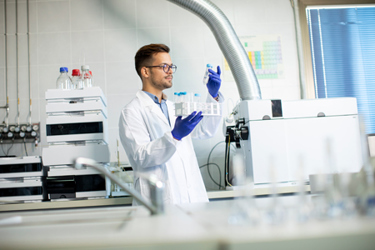The Growing Demand And Applications For HPLC
By Pankaj Singh, Global Market Insights

High-performance liquid chromatography (HPLC) is an analytical technique to separate, identify, and quantify components in a mixture. In this system, a pressurized liquid solvent with the sample mixture is passed through a column filled with solid adsorbent material, using a pump. Every component present in the sample interacts slightly differently with the adsorbent material. It leads to different flow rates for the different components and the separation of these components as they flow out of the column.
HPLC is widely used across biotechnology, pharmaceuticals, academics, food and beverage, environmental, and clinical applications. It is suited for drug development, quality control, forensic analysis, biochemical research, and other areas where the identification and quantification of components in complex mixtures is critical. The key benefits of HPLC include:
- the ability to detect sample components in very low concentrations,
- it can separate components with very similar chemical properties,
- it is suitable for the detection of a broad range of chemical compounds, and
- it provides reliable and precise data while automating the sampling and analysis.
The global HPLC market size is anticipated to exceed $7 billion in value by 2032, according to a report by Global Market Insights Inc (GMI). Growth factors include rising pharmaceutical and biotechnological R&D activities, technological improvements in HPLC instruments, surging drug development projects and approvals, food safety regulations demanding higher standards, and substantial investments in life sciences research.
Demand For Accurate And Precise Analytical Results
One of the main drivers of HPLC use is the increasing demand for accurate and precise analytical results in biotechnology, pharmaceuticals, food processing, and environmental testing. HPLC offers high accuracy, sensitivity, and reproducibility compared to other analytical techniques.
A University of Stuttgart research team is analyzing the impact of processed food on allergenic potential, which also involves the use of HPLC with mass spectrometry for allergen testing. In food products, it is important that consumers have accurate knowledge of the ingredients in products they buy off the shelf. During 2022, 42% of food recalls in the U.S. were attributed to undisclosed allergens, indicating strong prospects for using the testing speed and precision that the HPLC-MS combination can offer.
Increased R&D Spending And New Drug Development
The upsurge in medical research and development activities is also fueling the HPLC market. The technology is routinely used in R&D labs for drug discovery and preclinical and clinical development of novel drugs as it allows comprehensive analysis of potential drug candidates. Increased focus on new drug development for diseases with unmet medical needs is expected to drive R&D expenditures and, subsequently, the deployment of HPLC equipment and consumables.
In 2023, the top 10 pharma investors in the world, such as Merck, Roche, Novartis, Eli Lilly, GSK, and others, reported nearly $126 billion in total R&D spending. A correlation between R&D expenditure and the HPLC market could underscore a mutual symbiosis—where advancements in one domain feed into and fuel progress in the other.
Growth Of Biopharmaceutical Industry
The rapid expansion of the biopharmaceutical industry and the use of biologics such as monoclonal antibodies have led to greater utilization of HPLC techniques. The technique is critical in bioprocessing applications like purification and quality control of proteins, peptides, oligonucleotides, and other biomolecules. Unprecedented R&D spending, high adoption rates in Europe and North America, significant prevalence of chronic disorders, and other factors will influence the sector.
As per Trust for America’s Health, nearly 41.9% of adults in the U.S. are obese, while around 20% of children between the ages of 2 and 19 years were obese, according to 2017-2020 reports. Obesity can lead to several lifestyle and chronic diseases, such as diabetes, fatty liver, cardiovascular diseases, certain cancers, etc. The demand for suitable treatments to address the occurrence of obesity and other disorders will generate a substantial need for monoclonal antibodies and other biologics, bolstering HPLC applications.
Exploring The Applications Of HPLC In Biomanufacturing
Purify and separate biomolecules
A cornerstone application of HPLC in biomanufacturing is the purification of proteins, including monoclonal antibodies (mAbs), vital for therapeutic purposes. For instance, protein A chromatography, a subset of HPLC, is extensively used in the production of mAbs. The specificity and efficiency of HPLC facilitate the separation of desired molecules from complex mixtures, ensuring high purity and yield. mAbs are used in treating autoimmune disorders like rheumatoid arthritis, viral infections, certain cancers, and some other diseases.
According to WHO, more than 18 million people were suffering from rheumatoid arthritis in 2019 globally. The disease can cause lung, heart, or nervous system issues by damaging the joints and surrounding tissues if not treated. High occurrence of rheumatoid arthritis and related disorders will augment the consumption of effective treatments, driving biologics demand. GMI estimates suggest that the monoclonal antibodies industry will be worth over $600 billion by 2032.
Identify and quantify APIs
HPLC plays a vital role in the characterization of biopharmaceuticals, as the identification and quantification of the active pharmaceutical ingredients (APIs), assessing their potency, and detecting variants or impurities are essential. It also aids in the analysis of degradation products that may affect the safety and efficacy of the biopharmaceuticals. An API is, in essence, the biologically active component responsible for the desired therapeutic effects.
Regulatory agencies worldwide, including the U.S. FDA and the European Medicines Agency (EMA), impose stringent requirements on the production and characterization of APIs. Compliance with these standards is paramount, as deviations can lead to product recalls, regulatory sanctions, and significant safety risks to patients. For instance, in the biomanufacturing of insulin, an API with compromised purity due to process-related impurities can potentiate immunogenic reactions, posing serious health risks to diabetic patients.
A July 2020 publication by the EFPIA stated that the 27 European Union countries exported more than $83 billion worth of APIs in the previous year. A consistent rise in the development and use of APIs in biomanufacturing will fortify the need for critical testing methods such as HPLC.
Quality control and assurance
In biomanufacturing, HPLC ensures the integrity of biopharmaceutical products through stringent quality control (QC) processes. The technique's high sensitivity, specificity, and ability to cope with complex biological matrices make it invaluable for ensuring that the final product meets the stringent regulatory standards for purity, identity, and strength. In the era of advanced therapeutics, including cell and gene therapies, the role of QC becomes even more critical.
The personalized nature of these therapies, coupled with their complex production processes, amplifies the importance of robust QC measures to ensure that the highly specific quality attributes of these products are met consistently. The integration of quality by design (QbD) principles in biomanufacturing, which emphasizes understanding and controlling manufacturing variables, further highlights the importance of HPLC for QC.
Most companies in the industry are investing in continuous improvements of HPLC technology to ensure the production of high-quality therapeutics. For instance, in April 2024, Waters Corporation introduced a new HPLC system that will enable biopharma QC analysts to increase efficiency and eliminate up to 40% of common errors.
Monitoring of bioprocesses
HPLC is employed to closely monitor bioprocessing parameters, facilitating the optimization of production conditions. For example, HPLC analysis of amino acid concentrations during cell culture operations enables precise control over nutrient feed strategies, enhancing product yields. The adaptability and robustness of HPLC techniques contribute significantly to process analytical technology (PAT) frameworks, optimizing biomanufacturing outcomes.
Recently, Merck and Agilent Technologies expanded their collaboration by integrating PAT tools and the latter’s InfinityLab II Bio Online LC system, which is an ultra-high-performance liquid chromatography (ultra HPLC) system for real-time bioprocess monitoring. The solution will help provide analytical results directly at the production site by deploying the online HPLC with direct sampling capabilities along with Merck’s MAST platform.
In essence, ultra HPLC boasts of high efficiency, superior resolution, increased speed of analysis, and its ability to work with smaller samples and less solvent, making it both time and cost-effective. It is an advanced form of liquid chromatography that utilizes high pressure to push solvents through a column packed with sub-2-micron particle size stationary phase. The Merck-Agilent partnership will offer advantages such as real-time analysis, quality assurance, automation, and process optimization.
Bioprocess monitoring plays a critical role in facilitating process scalability and transferability, key challenges in the journey from clinical manufacturing to commercial production. By enabling early detection of process deviations, the HPLC methodology mitigates the risk of batch failures, thereby optimizing resource utilization and reducing financial attrition. These cost-efficiency measures resonate well with stakeholders, who seek assurance that biomanufacturing operations are both scientifically sound and economically prudent.
Conclusion
HPLC sets high standards for therapeutic biologics monitoring by providing sensitive, reproducible measurements. Biomarker analysis by HPLC can help screen for diseases, monitor disease progression, and evaluate therapeutic outcomes. It is also used in areas like forensic toxicology to detect drug abuse. As more biologics gain regulatory approval, demand for HPLC systems and consumables will rise.
With new HPLC applications in food testing, environmental analysis, forensics, and other fields, vendors are innovating products tailored to those applications. Technological improvements will lead to solutions delivering enhanced capabilities like higher sensitivity, throughput, and automation. These enhancements should make HPLC more appealing and drive the replacement of older systems.
HPLC provides vital and versatile analytical proficiency to laboratories in bioprocessing, biopharmaceuticals, and many other industries. Given its importance for R&D and quality control across diverse market segments, the HPLC market outlook remains positive, with steady expansion expected in the coming years.
About The Author:

Pankaj Singh is a writer at Global Market Insights who writes about business, technology, trade, and finance.
